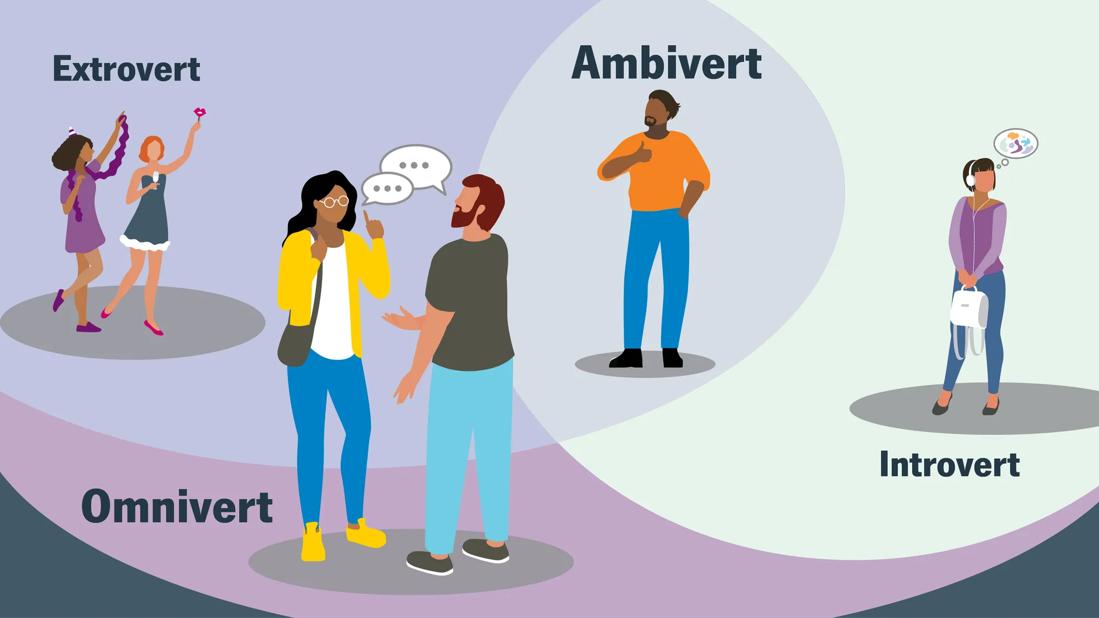Both types display introverted and extroverted tendencies, but the difference lies in the extremes

Some people feel their most energetic when they’re surrounded by new people and new places. Those are extroverts.
Advertisement
Cleveland Clinic is a non-profit academic medical center. Advertising on our site helps support our mission. We do not endorse non-Cleveland Clinic products or services. Policy
Others are most at peace when taking time for themselves. They’re introverts.
But not everyone falls squarely into one of those camps. Some people can be energized equally (or nearly equally) whether they’re out socializing or kicking back at home with a good book.
They’re either known as omniverts or ambiverts.
And the difference between the two lies in just how far they fall on the continuum between introversion and extroversion.
We talked with psychologist Darrielle Allen, PhD, about omniverts vs. ambiverts. What do they mean? And what’s the difference?
If you think of personality types as points along a spectrum, far on one side are introverts. Clear on the other are extroverts.
Hovering around the midpoint are ambiverts. They can teeter-totter between traits of both introversion and extroversion depending on the situation. But in a subtle way.
Omniverts can also show up as introverted or extroverted, depending on the situation. But in an exaggerated way.
Put another way, imagine a faucet of running water.
If you turn both sides of the tap on, you get a mix of hot and cold. That’s ambiversion.
But omniverts run either hot or cold. Nothing in between. Either one side is fully on, or the other is. And it switches back and forth. Steaming hot. Or icy cold.
Advertisement
“Unlike ambiverts, who maintain a balance, omniverts swing between the two far ends of the personality type spectrum,” Dr. Allen explains. “They might be the life of the party one day and then completely withdrawn the next, seeking solitude and reflection.”
An omnivert is someone who shifts between extreme introversion and extreme extroversion depending on the situation or based on their mood or energy level.
However they show up, whether introverted or extroverted, they’re all in. At least for that moment.
“The shifts can appear sudden or unpredictable to others. But for the omnivert, it’s often just a natural response to their internal needs,” Dr. Allen shares. “It’s not so much a matter of preference, as much as a reaction to what they need in that moment.”
While omniverts jump from one end of the spectrum clear across to the other, ambiverts occupy the space near the middle of the scale.
They shift between traits of introversion and extroversion, depending on what’s needed in a given situation. But maintain a balance of both.
Not too introverted. Not too extroverted. A sampling of both.
Perhaps the best way to understand omniverts and ambiverts is by looking at some common scenarios and how each might respond. Dr. Allen shares some examples.
Ambiverts are likely to adapt to the needs of a given project. In cases where they need to work with a team, they tend to be collaborative and engaged. When the situation calls for more independent work, they can put their heads down and get the task done.
Omniverts likewise can engage in both team projects and solo work, but with more gusto. They may dominate group conversations during meetings. And when they need to work alone, they may avoid interacting with others completely.
Consider both an ambivert and omnivert at a party.
The ambivert is one end of the party engaging in conversations, both with people they know well and with new friends. They leave when they feel satisfied — neither overly energized nor completely drained.
The omnivert is the center of attention, dominating conversation and leading the whole group in the conga line. The next party, though? They avoid going altogether, retreating instead to their favorite comfy spot in their bedroom.
Ambiverts usually engage with a balanced communication style. They listen thoughtfully and readily speak up to contribute their thoughts. They’re engaged conversation partners. In times of conflict, they commit to coming to a resolution collaboratively.
Advertisement
As for omniverts, it depends on their current state.
“An omnivert could either take charge and dominate the discussion, or withdraw entirely,” Dr. Allen states.
Your personality type is about how you manage your energy. How you charge your internal batteries.
It’s not about your mood or your ability to interact with the world around you. It’s about how those interactions leave you feeling.
So, when considering omniverts and ambiverts, Dr. Allen points out that it’s not a matter of how stable their mood is. It’s a question of whether their energy source is more or less balanced.
People who can more consistently be energized both in private and public settings are ambiverts. People who feel energized in a situation one day and drained by it the next are omniverts.
“Both omniverts and ambiverts are adaptable, capable of navigating social situations and solitude effectively,” Dr. Allen reinforces. “They share the ability to adjust their behavior to meet situational demands, making them versatile and well-rounded individuals.”
Advertisement
Learn more about our editorial process.
Advertisement

Openness, conscientiousness, extraversion, agreeableness and neuroticism all shape your core identity

Type A characteristics can fuel success, but they can also be a source of stress

Ambiverts tend to balance traits of both introverts and extroverts — and they’re more common

Extroverts are energized by people and places around them and tend to process thoughts out loud

Introverts tend to seek alone time to gain energy — they may keep small, close groups of loved ones and often think before they speak

This personality type involves three overlapping traits: Machiavellianism, narcissism and psychopathy

If you identify with this informal term, it may mean you have some addictive vulnerabilities

Subtler than narcissism, but a little more difficult to manage

The ‘sunshine vitamin’ is found naturally in some fish and is added to other foods

Autism and ADHD often go hand in hand, giving rise to the term AuDHD

The Yuzpe regimen is less effective than other forms of emergency contraceptives, and it’s associated with more side effects